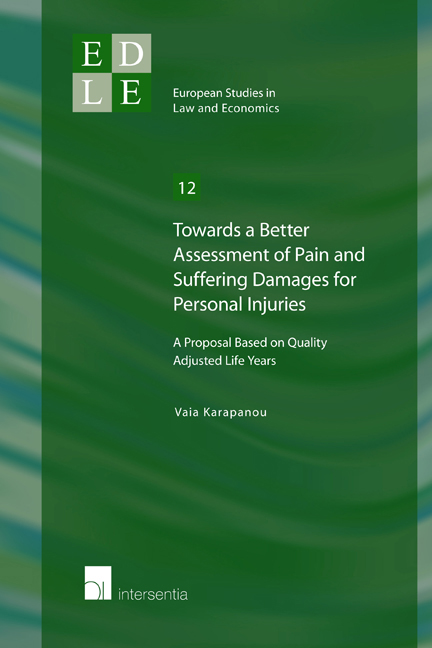 Towards a Better Assessment of Pain and Suffering Damages for Personal Injuries
Towards a Better Assessment of Pain and Suffering Damages for Personal Injuries Published online by Cambridge University Press: 22 November 2017
The method used to assess pain and suffering damages should, according to the previous chapters, take into consideration many different factors to be able to attain the goals of tort law as stipulated both by traditional legal theory and by law and economics. On the one hand, to achieve fair compensation and satisfaction, pain and suffering damages should reflect the total health reduction resulting from the personal physical injury. Therefore, factors such as the type, severity and duration of the injury, the pain and emotional strain incurred, as well as the loss in life expectancy, should figure in the assessment. On the other hand, to strike a balance between the goals of deterrence and insurance and promote both goals through the treatment of immaterial losses, pain and suffering damages should be based on the ex ante determined damages, namely the amount that a victim would be willing to forego before an accident occurs to reduce her expected immaterial losses.
Besides the ability to incorporate these features, the assessment should also generate consistent and predictable amounts. Consistency and predictability of the amounts will facilitate deterrence by allowing potential tortfeasors to take into consideration the prospect of having to pay a certain amount of damages if they inflict harm. Furthermore, it may also promote loss spreading by allowing insurers, product manufacturers and service providers to better predict the expected injury damages and incorporate them into the premiums offered. The analysis in the previous chapter showed that the assessment of pain and suffering damages should additionally be as accurate as necessary to reduce the administrative costs of justice. A proposal in this direction is to assess pain and suffering damages by taking into account the average losses resulting from a certain type of injury as well as the age of the victim. In any case, the assessment method implemented should strike a balance between the costs of additional accuracy and the benefits of that accuracy for the attainment of the aforementioned goals.
To save this book to your Kindle, first ensure [email protected] is added to your Approved Personal Document E-mail List under your Personal Document Settings on the Manage Your Content and Devices page of your Amazon account. Then enter the ‘name’ part of your Kindle email address below. Find out more about saving to your Kindle.
Note you can select to save to either the @free.kindle.com or @kindle.com variations. ‘@free.kindle.com’ emails are free but can only be saved to your device when it is connected to wi-fi. ‘@kindle.com’ emails can be delivered even when you are not connected to wi-fi, but note that service fees apply.
Find out more about the Kindle Personal Document Service.
To save content items to your account, please confirm that you agree to abide by our usage policies. If this is the first time you use this feature, you will be asked to authorise Cambridge Core to connect with your account. Find out more about saving content to Dropbox.
To save content items to your account, please confirm that you agree to abide by our usage policies. If this is the first time you use this feature, you will be asked to authorise Cambridge Core to connect with your account. Find out more about saving content to Google Drive.